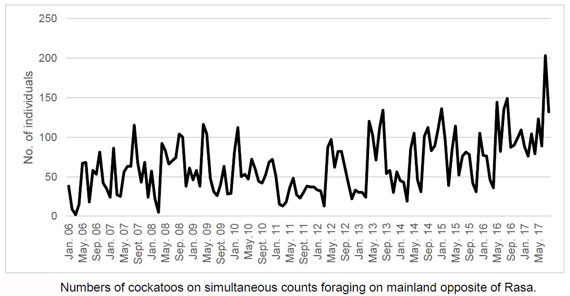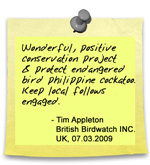Where we work
Rasa Island Wildlife Sanctuary (RIWS)
Certainly, the most convenient way to see the Philippine
cockatoo in the wild is to visit Rasa Island!
Rasa is a small coral island of 8.34 km2 area situated in the
Sulu Sea, just off the shore of the Municipality of Narra,
Palawan, Philippines. About 1.75 km2 are covered with coastal
forest, mangrove (5.60 km2), cultivated areas (predominantly
coconut; 0.39 km2), 0.60 km2 are barren or sparsely vegetated
sand and coral outcrops
 The island is the pilot site of the program since 1998. Key
component of this project site is the wardening scheme which
involves patrolling and protection of the birds during and outside
the breeding season. This scheme has proven to be very efficient. It
has increased the population of cockatoos nearly tenfold on the
island over ten years (presently ca. 200 birds)! The island is the pilot site of the program since 1998. Key
component of this project site is the wardening scheme which
involves patrolling and protection of the birds during and outside
the breeding season. This scheme has proven to be very efficient. It
has increased the population of cockatoos nearly tenfold on the
island over ten years (presently ca. 200 birds)!
Rasa Island probably holds the highest population density of
Philippine cockatoo that remains in the wild!

The world population of Philippine cockatoo was estimated to
range between 1,000 to 4,000 individuals (Lambert, 1994). More
recent estimates put the number of cockatoos remaining in the wild
between 870 and 2,300 (Widmann, 2001). About 70 to 75% of this
population is probably found in Palawan (Boussekey, 2000). This
makes Rasa a high priority area for the protection of this species.
 More so, not only Philippine cockatoos live on the island, but a
variety of other species, with an unusual high percentage of
globally threatened and near-threatened taxa (IUCN 2008),
considering the small size of Rasa. Noteworthy among the 104
recorded bird species are Grey imperial pigeon Ducula pickeringii
and Mantanani scops owl Otus mantananensis. Marine life around Rasa
is also diverse with at least three marine turtle species and Dugong
Dugong dugon recorded. More so, not only Philippine cockatoos live on the island, but a
variety of other species, with an unusual high percentage of
globally threatened and near-threatened taxa (IUCN 2008),
considering the small size of Rasa. Noteworthy among the 104
recorded bird species are Grey imperial pigeon Ducula pickeringii
and Mantanani scops owl Otus mantananensis. Marine life around Rasa
is also diverse with at least three marine turtle species and Dugong
Dugong dugon recorded.
Pride of Rasa Island!

Rasa Island was declared Wildlife Sanctuary through Philippine
Presidential Proclamation 1000 in 2006. Because of its features, the
Municipality of Narra is now called the “Philippine Cockatoo Capital
of the World”. Recently, it was named as one of the 13 top
birdwatching sites in the Philippines by the Philippine Department
of Tourism (PDOT) and was promoted during the 2009 World Travel
Market in London. It is included in the PDOT’s published guidebook
“Birdwatching in the Philippines Volume 1”.
back to top▲
|